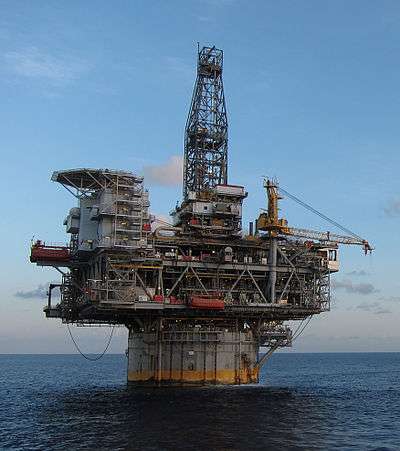Spar (platform)

A spar is a type of floating oil platform typically used in very deep waters, and is named for logs used as buoys in shipping that are moored in place vertically. Spar production platforms have been developed as an alternative to conventional platforms.[1] The deep draft design of spars makes them less affected by wind, wave and currents and allows for both dry tree and subsea production. Spars are most prevalent in the US Gulf of Mexico; however, there are also spars located offshore Malaysia and Norway.[2]
A spar platform consists of a large-diameter, single vertical cylinder supporting a deck. The cylinder is weighted at the bottom by a chamber filled with a material that is more dense than water to lower the center of gravity of the platform and provide stability.[3] Additionally, the spar hull is encircled by helical strakes to mitigate the effects of vortex-induced motion. Spars are permanently anchored to the seabed by way of a spread mooring system composed of either a chain-wire-chain or chain-polyester-chain configuration.[4]
There are three primary types of spars; the classic spar, truss spar, and cell spar. The classic spar consists of the cylindrical hull noted above, with heavy ballast tanks located at the bottom of the cylinder.
A truss spar has a shorter cylindrical "hard tank" than a classic spar and has a truss structure connected to the bottom of the hard tank. This truss structure consists of four large orthogonal "leg" members with X-braces between each of the legs and heave plates at intermediate depths to provide damping. At the bottom of the truss structure, there is a relatively small keel, or soft tank, that houses the heavy ballasting material. Soft tanks are typically rectangular in shape but have also been round to accommodate specific construction concerns.[5] The majority of spars are of this type.[2]
A third type of spar, the cell spar, has a large central cylinder surrounded by smaller cylinders of alternating lengths. At the bottom of the longer cylinders is the soft tank housing the heavy ballasting material, similar to a truss spar. The cell spar design was only ever used for one platform, the Red Hawk spar,[6] which was decommissioned in 2014 under the Bureau of Safety and Environmental Enforcement's "Rigs-to-Reefs" program. At the time of its decommissioning it was the deepest floating platform to ever be decommissioned.[7]
The Brent Spar, a platform designed for storage and offloading of crude oil products, was installed in the Brent Field in June 1976. The attempted deep sea disposal of the platform in the 1990s created a huge backlash by Greenpeace. The Spar was eventually dismantled and pieces were used as a foundation for a quay in Norway.[8]
The first spar designed for oil and gas production was the Neptune spar, located in the Gulf of Mexico and was installed in September 1996 by Kerr McGee (now Anadarko).[9]
The world's deepest production platform is Perdido, a truss spar in the Gulf of Mexico, with a mean water depth of 2,438 meters. It is operated by Royal Dutch Shell and was built at a cost of $3 billion.[10]
See also
References
- ↑ www.fmctechnologies.com "Annual Report - Glossary of Terms"
- 1 2 Offshore Magazine "2014 DEEPWATER SOLUTIONS & RECORDS FOR CONCEPT SELECTION"
- ↑ Rigzone "How Do Spars Work?"
- ↑ Offshore Magazine "State-of-the-art of spread moored systems for deepwater floating production platforms"
- ↑ Oil and Gas Journal "New spar installed in gulf"
- ↑ "Cell spar enables Red Hawk development"
- ↑ "Deepest GoM decom job complete"
- ↑ Brent Spar Dossier, Shell
- ↑ www.naturalgas.org "Spar Platforms"
- ↑ Shell starts production at Perdido
External links
| Wikimedia Commons has media related to Spar platforms. |
- GlobalSecurity.org page on spar platforms - containing detailed diagrams